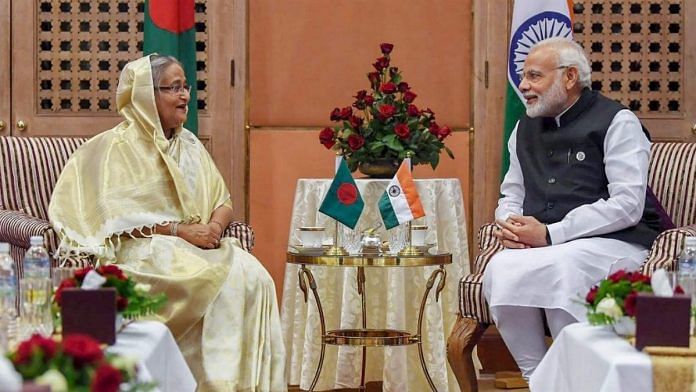New Delhi: A Comprehensive Economic Partnership Agreement (CEPA) between India and Bangladesh is in Dhaka’s interest, as this will help it retain trade benefits when it graduates from the UN’s least-developed country (LDC) bracket in 2026, according to analysts.
However, the full potential of a CEPA will not be realised unless cooperation is deepened through transport linkages, they added.
India is in the midst of negotiating several free trade agreements (FTAs) with countries including Australia, the UAE, the UK, Israel, and Canada, as well as the European Union. Bangladesh is doing the same, largely with Asian countries, including Thailand, Sri Lanka, the Philippines, and Singapore.
India and Bangladesh are already part of a regional preferential trading arrangement, the South Asian Free Trade Area (SAFTA), an FTA for members of the South Asian Association for Regional Cooperation (SAARC). However, a CEPA is an advanced form of free trade agreement that will ensure preferential and even tariff-free access to goods, services and investments in both countries.
With a total trade volume of $10 billion, Bangladesh is India’s biggest trading partner in South Asia, while India is Bangladesh’s second-largest trading partner after China. Bangladesh’s exports to India have tripled over the past decade, indicating a fast-growing trade relationship.
According to data from the commerce ministry, imports from Bangladesh have gradually increased even through the pandemic. They stood at $685 million in 2017-18, $1.04 billion in 2018-19, $1.26 billion in 2019-20 and $1.09 billion in 2020-21. Meanwhile, Indian exports to Bangladesh hovered at around $9 billion in the same four years.
Also read: Govt and military owe India an authentic history of the 1971 Bangladesh War. Rest is mythology
‘Bangladesh needs to explore new market opportunities’
In 2026, Bangladesh will graduate to the UN’s developing country bracket. Although it will likely enjoy the trade benefits of an LDC for three more years, it will need to explore new options, said Prabir De, professor at the Research and Information System for Developing Countries (RIS), a Delhi-based think-tank under the Ministry of External Affairs.
“All the trade concessions that Bangladesh is getting from the US, Europe and other countries will end in 2026 in a phased manner. So, it needs to explore new market opportunities through such deals,” De told ThePrint.
“At the outset, India’s strong exports in services and Bangladesh’s exports in goods are a good cause to have a CEPA. But I imagine Bangladesh would use a CEPA with India to leverage its strategic position in South Asia. It will likely go for an FTA with China after India’s is confirmed,” he added.
Gaps between actual and potential trade
In October this year, High Commissioner Doraiswami said that if New Delhi and Dhaka improved their connectivity, exports from Bangladesh to India would jump by 182 per cent, and a signed CEPA would see a rise of 297 per cent.
However, according to Mustafizur Rahman, distinguished fellow at the Centre for Policy Dialogue (CPD), a Dhaka-based think-tank, trade on the ground tells a different story.
“There are large gaps between actual and potential trade between Bangladesh and not just India, but South Asia,” Rahman told ThePrint.
A 2018 World Bank study found that trading between countries in South Asia costs about 20 per cent more than trading between some South Asian countries and those in South America, such as Brazil. For example, the cost of trade between Bangladesh and Nepal was found to be 1.5 times higher than that for trade between Bangladesh and Brazil.
This is despite India extending three lines of credit to Bangladesh in the past eight years, amounting to $8 billion, for the development of roads, railways, shipping and ports — the biggest concessional LOC New Delhi has offered a country.
“Cooperation between India and Bangladesh needs to be deepened through investment and transport linkages. Two SEZs in Bangladesh have been earmarked exclusively for investors from India — these are building blocks for now,” said Rahman.
“India and Bangladesh’s land-based linkages lack formalisation of customs. Loading and unloading at no man’s land takes time and costs more. Hopefully, when operationalised, the BBIN Motor Vehicle Agreement (MVA) will solve many of the attendant bottlenecks,” he added.
The BBIN MVA is an agreement between Bangladesh, Bhutan, India, and Nepal to facilitate seamless flow of passenger, personal and cargo vehicular traffic. It was signed in June 2015 but is yet to be implemented, with Bhutan having opted out of it for now.
(Edited by Rohan Manoj)
Also read: Tibet, Buddhism, India-Pak tension — 3 factors that define China’s foreign policy in South Asia






